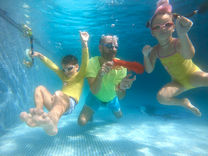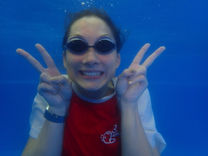What if children, swimmers, get cramps while swimming?
In the calm water, the unrest was brought by a cramp in the boy’s leg while he was swimming in the sea. After his cry and panic, I jumped in and pulled him ashore. The boy was 18 years old and he was swimming with his friends at the almost wild beach on an island. There were no lifeguards nearby and there weren’t many people.
Has your child ever had a cramp while swimming?
When I was a younger swimmer, I used to get muscle cramps in my leg, calf, and sometimes my foot. Primarily due to insufficient hydration and intensive trainings. In the past, children did not have a habit of carrying a bottle of water to swimming, so we would jump out of the water in the middle of the training and run to the toilet to drink tap water. Today, swimmers, even the youngest ones, are often seen keeping a bottle of water near the edge of the pool, which is good because once you get thirsty it is already too late.
Anyone can get cramps in the water, whether it is a younger or an older swimmer.
What can every child, a swimmer, do in case he or she gets muscle cramps while in the water?
If a swimming child is far from the shore and he gets cramps while in the water all by himself, without anyone to help him, the first thing to remember is to stay hydrated enough before entering the water, especially in summer days when we sweat a lot, even in the water. It is important to remember not to jump into the water after running on the beach, playing or doing similar activities, as oftentimes the overheating of the organism that jumps into the water can cause muscle cramps.
Once the cramps occur, it is quite difficult to relax that part of the body unless you have a support nearby, to hold on. So, if the child gets muscle cramps while swimming on his own, it is important to start the phase of body resting immediately, that is, to turn on the back and float. In that way, the part of the body where the spasm occurred will relax a bit. If there is a toe or foot cramp, it often helps when you pull the toes towards yourself, and then the whole foot so as to relax the part affected by the unpleasant pain. If there is a calf cramp, it is of help to pinch that part as tightly as possible (strong grip) in order to resume the blood circulation.
Prevention and education on how to stay safe in the water is a priority!
This is why swimming schools organise, as a form of prevention, water safety weeks when children go through all possible unwanted situations in and near the water, simulating cramp situations while swimming. In those classes, fully dressed children swim in the pool (wearing shorts, T-shirts) without wearing a cap or goggles in order to get a real feeling and weight of the water in case of an accident. On the other hand, swimming children (if attending swimming lessons) can learn advanced personal and rescue skills in those lessons through play: including turning to the side, turning on and in the water, floating with and without props, and how to behave after jumping or falling in the water.
What do children need to be told when they go swimming with friends?
That they must be aware of the fact that they themselves are not lifeguards. That in such situations they should give their best, but first protect themselves, so as not to cause a double tragedy. It might sound selfish at first, but unless there is a lifeguard, a professional or an adult nearby who can help, the first thing they need to do is find a floating device (a board, ball, plastic water canister) or a rope (T-shirt, trousers, belt, branch) to throw to a drowning person.
Prevention and education on the safety of children in and around the water can potentially save someone's life! The responsibility lies with all of us, both swimming coaches and parents.



















































Comments